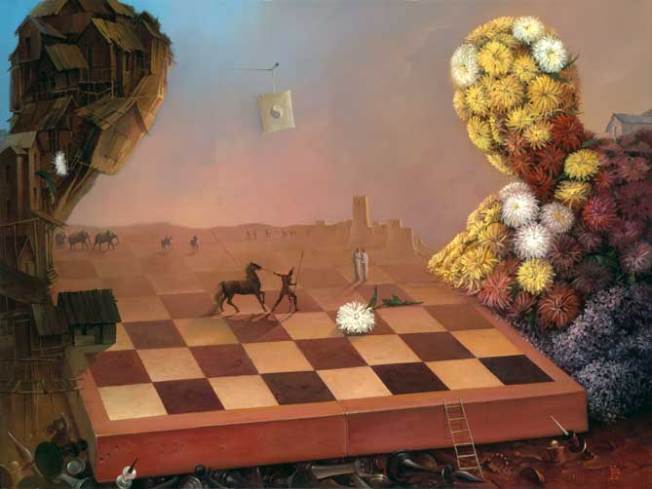“To explore the truth, to seek it in the ethnic domain […] as well as in that of the imagination, such are the chief characteristics of this new spirit.” (Apollinaire)
My first impression of Surrealism years ago was that I didn’t like it. I thought it was too far-fetched, and far too embedded in fantasy to be interesting, or to have any importance. However, lately I have been researching Surrealism again, only this time I found that the opposite is true, and I am now standing corrected.

Salvador Dali
Image Source
Surrealism is not rooted in fantasy, but instead it could be seen as a form of superior reality, where problems and contradictions are solved through art and an open mind. Its aim is not to replace reality, but rather to bring our unconscious and subconscious to our attention so we may understand it better.
Surrealist paintings and poems were meant to give shape to our dreams and deepest, most secret desires and longings. The Surrealists believed that our inspiration comes from the depths of being, from the domain of our unconscious and subconscious, and that it was important to maintain that connection outside of art, which suggests an entire mindset (which has often been argued to not exist at all where Surrealism is concerned.)
Author Sarane Alexandrian summarises its aim well:
“The Poets and Painters who gathered under the black banner of surrealism claimed to be ‘specialists in revolution’. They banded together to protest against intellectual privilege and intellectual malpractice. They affirmed the rights of the dream, of love, of awareness, and they joined in encouraging the mind to be open to wild encounters and to the surprises afforded by chance.” (from ‘Surrealist Art’)

Man Ray
Image Source
One of Surrealism’s main influences is poetry. The Surrealists revered two poets in particular: Apollinaire, who was titled as the “last great poet” by Breton; and Lautréamont, who they revered more than any other poet. However, they were not the only ones who had influenced the movement. Others, such as Jarry, Rimbaud, Baudelaire and Reverdy had also made their mark on the movement, just not to the same extent.
It is also impossible to disregard the importance of Dada on Surrealism. Tzara (the founder of Dada) and Breton (one of the founders of Surrealism) disagreed on many things, but worked together and shared ideas for a while nevertheless. However, one night during one of Tzara’s performances, both movements came to a blow when Breton and one of his co-founders Péret were physically abused and injured. (I won’t go into much detail here now, but if you wish to know more I recommend “The History of Surrealism”, by Maurice Nadeau)
And finally, Freud’s writings on psychoanalysis were also a great influence. At the time, many people either didn’t agree with his theories or simply didn’t think them of any value. Some were even scared or disturbed by the implications they carried. The Surrealists, however, were fascinated and embraced Freud’s theories about the mind and the meaning of dreams.

Victor Bregeda
Image Source
Unfortunately, Surrealism has often been regarded as an opponent to reason and logic over the years. Many writers have attempted to discredit it altogether, and attempts have been made to stop the public from putting any confidence into the movement. I myself have been wondering if Surrealism might be a state of madness, and whether some of its members may actually have been insane.
Looking at Jarry and Rimbaud, who weren’t happy with who they were and rather spent their lives pretending to be someone else (rather successfully, according to Breton), it might be easy to see why. Pretending to the extend that these two poets have done could be seen as signs of MPD or possibly even schizophrenia. While the Surrealists weren’t able to recreate what these two poets were doing, they admired it and attempted it themselves occasionally.
It’s no secret that people who suffer from mental health issues are closer to their subconscious through hallucinations, or delusions (just to name a few). That does not mean, however, that it’s impossible to be in touch with your unconscious and/or subconscious if you’re completely sane (then again, who is, these days?). Surrealism teaches to have an open mind, and to show the world our dreams, underlying fears and secret desires.
Insanity might make it easier, but it’s not impossible for everyone else. Our dreams and subconscious are a part of all of us, so why should we ignore them? There is much truth and beauty to be found if only we dig deep enough. Sadly, these days, most people won’t think it worth their time, or a ridiculous fantasy, even.
But it doesn’t have to be. Open your minds, and see where it can take you when you close your eyes.
You’ve got your mind for many reasons. Logic isn’t the only one.
Use it to its full potential, and see what you might find.
———————————————————————————————————————————-
If I have sparked your interest in Surrealism, I highly recommend the following books for you:
The History of Surrealism, by Maurice Nadeau
Surrealist Art, by Sarane Alexandrian
The Surrealist Mind, by J.H. Matthews